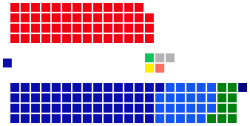| 44th Parliament of the Commonwealth of Australia | |
|---|---|
43rd ← → 45th | |
 | |
12 November 2013 – 9 May 2016 | |
| Members | 76 senators 150 representatives |
| Senate Leader | Eric Abetz (until 21 September 2015) George Brandis (from 21 September 2015) |
| Senate President | Stephen Parry (from 7 July 2014) |
| House Leader | Christopher Pyne (from 12 November 2013) |
| House Speaker | Bronwyn Bishop (until 2 August 2015) Tony Smith (from 10 August 2015) |
| Sessions | |
| 1st: 12 November 2013 – 15 April 2016 2nd: 18 April 2016 – 5 May 2016 [1] | |
The 44th Parliament of Australia was a meeting of the legislative branch of the Australian federal government, composed of the Australian Senate and the Australian House of Representatives.



